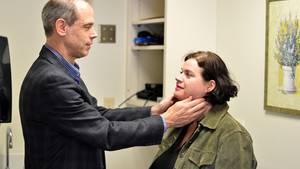 |
Emergency medicine residents Drs. Josh MacNeil, Heather Flemming, Raphael Panais and Jason Emsley work through a ski accident simulation exercise at the Sim Bay at the QEII’s Charles V. Keating Emergency and Trauma Centre. (Contributed) |
 |
Medical student Nada Ismaiel and Drs. David MacDonald, Joshua Gillis and Michael Vargo take part in a simulation exercise using a mannequin at the Atlantic Health Training and Simulation Centre at the QEII. (Contributed) |
 |
Dr. Babar Haroon teaches Drs. Chinyere Iwuala and Bader Alamri ultrasound guided central line placement technique on a task trainer at the Skills Centre for Health Sciences. (AMac Photography) |
 |
An ophthalmology resident practices cataract surgery on the EyeSi simulator. Cataract and retinal surgery is extremely delicate and precise so it is very important that the residents have a place to practice and make mistakes with no harm to patients. (Contributed) |
 |
Dr. John Igoe teaches Dr. Matthew Miles how to perform a paracentesis on a clinical grade cadaver as Dr. Joshua Green observes. Paracentesis is a procedure to remove fluid that has collected in the belly as a result of infection, inflammation, injury or other conditions such as cirrhosis or cancer. (AMac Photography) |
 |
Trainees use the laparoscopic surgery simulators to gain hand eye coordination or do complex procedures like gall bladder surgery or laparoscopic suturing on tissue. (Contributed) |
 |
Dr. Alison Rodger teaches Dr. Aimee Noël how to perform a lumbar puncture on a task trainer as Dr. Heather Mackenzie observes. A procedure to collect and examine the fluid surrounding the brain and spinal cord, a lumbar puncture is used to test for and diagnose conditions such as meningitis, inflammation, cancer and Multiple Sclerosis. (AMac Photography) |
 |
Participants in the third annual Canadian Neurosurgery Rookie Camp gather outside the Skills Centre for Health Sciences at the QEII’s Bethune Building. The two-day education and training session for national neurosurgery residents was established in 2012 by Dr. David Clarke, Director of the Rookie Camp and Head and District Chief of the Division of Neurosurgery. The QEII is home to Atlantic Canada’s only neurosurgery residency training program. (Fairfield Creative) |
Simulation is a technique of modeling real-life situations to provide training in an interactive environment. Participants are able to rehearse scenarios and refine skills, without risk, so they are better prepared for actual experiences. It is also a valuable way to refine problem-solving and decision-making abilities along with interpersonal, communication and teamwork skills. As the largest teaching hospital and academic health sciences centre in Atlantic Canada, the QEII is investing in simulation-based learning for the over 4,000 trainees using simulation facilities at the health centre each year.
The QEII has passionate staff and enthusiastic instructors using its three simulation facilities including:
Atlantic Health Training and Simulation Centre, or Sim Centre, located in the QEII’s Centennial Building, VG site, and involves mannequin-based simulators, a debriefing room and control room;
Skills Centre for Health Sciences at the QEII’s Bethune Building, VG site, giving trainees and professionals a place to learn and practice surgical techniques; and
Emergency Medicine Simulation Bay, or Sim Bay, at the QEII’s Charles V. Keating Emergency and Trauma Centre at the HI site that mirrors a trauma room.
The QEII Foundation is raising funds to transform the current structure into a robust, thriving network of top-notch facilities. To be part of the future of learning, please contact the QEII Foundation at 902 473 7932 or visit QE2Foundation.ca.
















